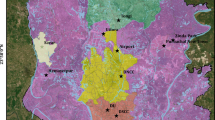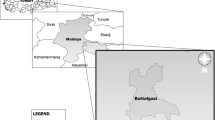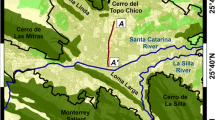Abstract
This paper investigates the influence of local geotechnical and geological soil conditions on the intensity of ground shaking of major cities in United Arab Emirates (UAE) including Abu Dhabi, Dubai, and Sharjah, and their surrounding areas. Two time histories for each city were chosen based on the target response spectrum that was obtained from results of probabilistic seismic hazard analysis conducted in previous study for UAE. Subsurface geotechnical data from more than hundred different sites were used to evaluate the effect of local site conditions on ground response during earthquake. Dynamic properties of soil for selected soil profiles have been generated, and one-dimensional site response analysis has been conducted. Results are presented in terms of response spectral accelerations (RSA) for different site classes in each city. RSA results indicated that the surficial deposits in the studied areas have the ability to amplify earthquake ground motion significantly with peak amplification at relatively narrow frequency range of 1.5–5 Hz (0.2–0.67-s period). This frequency range was found to be a representative of the predominant frequency ranges of the site classes under consideration. At higher frequencies, slight amplification, and in some cases slight attenuation, is observed. Design response spectra for each site class in each city were developed based on the results of site response analysis. The developed design response spectra were compared with spectrum currently used in each city, and the modified site coefficient is presented.















Similar content being viewed by others
References
Abdalla JA, Al Homoud AS (2004) Seismic hazard assessment of United Arab Emirates and its surroundings. J Earthq Eng 8(6):817–837
Abdalla JA, Petrovski JT, Mohamedzein YEA (2008) Vibration characteristics of a far field earthquake and its shaking effects on Dubai emerging skyscrapers. In: Proceedings of the 14th World conference on earthquake engineering (14WCEE), Beijing, China October 12–17
ADIBC (2013) Abu Dhabi international building code. Abu Dhabi Municipality, UAE. http://abudhabibuildingcodes.ae
Al Bdour W (2005) Seismic hazard assessment and mitigation of earthquake risk in United Arab Emirates. Thesis submitted for Department of Civil Engineering, University of Science and Technology, Jordan
Aldama-Bustos G, Bommer JJ, Fenton CH, Stafford P (2009) Probabilistic seismic hazard analysis for rock sites in the cities of Abu Dhabi, Dubai and Ras Al Khaimah, United Arab Emirates. Georisk 3(1):1–29
Ansal A, Kurtulus A, Tonuk G (2008) Assessment of seismic hazard and risk in Dubai, United Arab Emirates. Final project report part C, microzonation for site conditions, Dubai, UAE
Athanasopoulos GA (1995) Empirical correlations Vs-NSPT for soils of Greece: a comparative study of reliability. In: Cakmak AS, Brebbia CA (eds) Proceedings of the 7th international conference on soil dynamics and earthquake engineering, Chania, Greece, pp 19–26
Balwan M (2008) Influence of local soil conditions on ground response-site amplification. Thesis submitted for Department of Civil Engineering, University of Sharjah, UAE
Bazzuro P, Cornell CA (1999) Disaggregation of seismic hazard. Bull Seismol Soc Am 89:501–520
Bommer JJ, Avecedo AB (2004) The use of real earthquake accelerograms as input to dynamic analysis. J Earthq Eng 8(1):43–91
Borchedt RD (2002) Empirical evidence for acceleration-dependent amplification factors. Bull Seismol Soc Am 92(2):761–782
Celebi M, Dietel C, Prince J et al (1987) In: Cakmak AS (ed) Site amplification in Mexico city determined from 19th September strong-motion records and from recordings of weak motions. Ground Motion and Engineering Seismology, Elsevier, pp 141–152
Chapman MC (1995) A probabilistic approach to ground motion selection for engineering design. Bull Seismol Soc Am 85:937–942
Chapra SC, Canale RP (2006) Numerical methods for engineering, 5th edn. McGraw-Hill, New York
Chary KB, Sarma LP, Prasanna Lakshmi KJ et al (2006) Evaluation of engineering properties of rock using ultrasonic pulse velocity and uniaxial compressive strength. Proceedings in National Seminar on Non-Destructive Evaluation, Hyderabad, India
Das BM, Ramana GV (2011) Principles of soil dynamics, 2nd edn. Cengage Learning, Stamford, CT
Day RW (2002) Geotechnical earthquake engineering handbook. McGraw-Hill, New York
Dobry R, Vucetic M (1987) State of the art report: dynamic properties and response of soft clay deposits. In: Proceedings of the international symposium on geotechnical engineering of soft soils, Mexico City, vol 2, pp 51–87
Dobry R, Borcherdt RD, Crouse CB (2000) New site coefficients and site classification system used in recent building code provisions. Earthq Spectra 16(1):41–68
Fenton CH, Adams J, Halchuk S (2006) Seismic hazards assessment for radioactive waste disposal sites in regions of low seismic activity. Geotech Geol Eng 24(3):579–592
Gotkan RM (1988) Theoretical and practical analysis of rock rippability. Ph.D. Thesis, Istanbul Technical University
Harmsen S, Perkins D, Frankel A (1999) Disaggregation of probabilistic ground motions in the central and eastern United States. Bull Seismol Soc Am 89:1–13
Hasancebi N, Ulusay R (2006) Empirical correlations between shear wave velocity and penetration resistance for ground shaking assessments. Bull Eng Geol Environ 66:203–213
Hays WW (1975) A note on the duration of earthquake and nuclear explosion ground motions. Bull Seismol Soc Am 65:875–884
Huang HHM, Lee CS (1991) Parametric study of site response analysis. Soil Dyn Earthq Eng 10(6):282–290
IBC (2012) International building code. International Code Counsel, ICC Inc., USA
Idriss IM (1990) Response of soft soil sites during earthquakes. In: Proceedings of H. Bolton seed memorial symposium, BiTech Publication, pp 273–290
Idriss IM, Sun JI (1992) SHAKE91—a computer program for conducting equivalent linear seismic response analyses of the horizontally layered soil deposits. Program modified based on the original SHAKE program published in 1972 by Schnabel, Lysmer, and Seed. University of California, Berkeley, Calif
Irfan M (2011) Seismic site response, analysis and characterization of major cities in U.A.E. M.Sc. Thesis, American University of Sharjah, Sharjah, UAE
Irfan M, El-Emam M, Khan Z, Abdalla J (2012) Analysis of local site effects on seismic ground response of Dubai-Sharjah metropolitan area. Geotechnical special publication, no. 225 GSP, ASCE, pp 1869–1878
Iyisan R (1996) Correlations between shear wave velocity and in situ penetration test results. Tech J Turkish Chamber Civil Eng 7(2):1187–1199 (in Turkish)
Johnson PR (1998) Tectonic map of Saudi Arabia and adjacent areas. Technical report, USGS-TR-98-3 (IR 948), US Geological Survey
Johnston AC (1994) The stable continental region earthquake database. In: Schneider J, Palo A (eds) The earthquakes of stable continental regions: assessment of large earthquake potential, EPRI Rpt. TR-102261, pp 1–80
Karadeniz E (2008) Ground motion sensitivity analysis for the greater St. Louis metropolitan area. M.Sc. Thesis, Missouri University of Science and Technology, Missouri, USA
Khan Z, El-Emam M, Irfan M, Abdalla J (2013) Probabilistic seismic hazard analysis and spectral accelerations for United Arab Emirates. Natural Hazard 67(2):569–589
Khandelwal M, Singh TN (2009) Correlating static properties of coal measure rocks with P-wave velocity. Int J Coal Geol 79:55–60
Kim DS, Chung CK, Sun CG, Bang ES (2002) Site assessment and evaluation of spatial earthquake ground motion of Kyeongju. Soil Dyn Earthq Eng 22:371–387
Kramer SL (1996) Geotechnical earthquake engineering. Prentice Hall, New Jersey, p 653
Kusky T, Robinson C, El-Baz F (2005) Tertiary-quaternary faulting and uplift in the northern Oman Hajar Mountains. J Geol Society 162(5):871–888
Malkawi HA, Barakat S, Shanableh A et al (2007) Seismic hazard assessment and mitigation of earthquake risk in United Arab Emirates. Technical report UOS-3, University of Sharjah, United Arab Emirates
McGuire RK (1995) Probabilistic seismic hazard analysis and design earthquakes: closing the loop. Bull Seismol Soc Am 85(5):1275–1284
Murphy JR, Weaver NL, Davis AH (1971) Amplification of seismic body waves by low-velocity layers. Bull Seismol Soc Am 61(1):109–146
NEHRP (2003) Recommended provisions for seismic regulations for new buildings and other structures. BSSC-building seismic safety council, 2000 edn, part 1: provisions (FEMA 368), Ch. 4, Washington, DC
NEHRP (2009) Recommended provisions for seismic regulations for new buildings and other structures: FEMA P-750. Federal Emergency Management Agency, Washington, DC, USA
Ozkahraman HT, Selver R, Isık EC (2004) Determination of the thermal conductivity of rock from P-wave velocity. Int J Rock Mech Min Sci 41:703–708
Paz M, Leigh W (2004) Structural dynamics: theory and computation, 5th edn. Springer, New York
Pitarka A, Irikura K (1996) Basin structure effects on long-period strong motions in the San Fernando Valley and the Los Angeles Basin from the 1994 Northridge earthquake and an aftershock. Bull Seismol Soc Am 86(1B):S126–S137
Rayhani MH, El Naggar MH, Tabatabaei SH (2007) Nonlinear analysis of local site effects on seismic ground response in the Bam earthquake. Geotech Geol Eng 26(1):91–100
Romero MS, Rix GJ (2001) Ground motion amplification of soils in the Upper Mississippi Embayment. (GIT-CEE/GEO-01-1): Georgia Institute of Technology, School of Civil and Environmental Engineering, p 493
Schnabel PB (1973) Effects of local geology and distance from source on earthquake ground motions. Ph.D. Thesis, University of California, Berkeley, USA
Schnabel PB, Lysmer J, Seed HB (1972) SHAKE, a computer program for earthquake response analysis of horizontally layered sites. Report no. UCB/EERC-72/12, University of California, Berkeley, USA
Seed HB, Idriss IM (1970) Soil moduli and damping factors for dynamic response analyses. Report no. EERC 70-10, University of California, Berkeley, USA
Seed HB, Idriss IM (1981) Evaluation of liquefaction potential sand deposits based on observation of performance in previous earthquakes. ASCE National Convention (MO), pp 81–544
Seed HB, Idriss IM (1982) Ground motion and liquefaction during earthquake monograph series. Earthquake Engineering Research Institute, El Cerrito, California, USA
Shibata T (1970) Analysis of liquefaction of saturated sand during cyclic loading. Disaster Prev Res Inst Bull 13:563–570
Sun CG, Kim DS, Chung CK (2005) Geologic site conditions and site coefficients for estimating earthquake ground motions in the inland areas of Korea. Eng Geol 81:4, 446
Wolf JP (1985) Dynamic soil-structure interaction. Prentice-Hall, Englewood Cliffs, NJ
Yasar E, Erdogan Y (2004) Correlating sound velocity with the density, compressive strength and young’s modulus of carbonate rocks. Int J Rock Mech Min Sci 41:871–875
Acknowledgments
This study is part of the research being performed for the assessment of seismic site response of major cities in UAE. Extensive amount of geotechnical information has been acquired from many organizations. The authors extend their appreciation to Abu Dhabi Municipality and Sharjah Municipality for valuable information and discussions.
Author information
Authors and Affiliations
Corresponding author
Rights and permissions
About this article
Cite this article
El-Emam, M., Khan, Z., Abdalla, J. et al. Local site effects on seismic ground response of major cities in UAE. Nat Hazards 79, 791–814 (2015). https://doi.org/10.1007/s11069-015-1873-9
Received:
Accepted:
Published:
Issue Date:
DOI: https://doi.org/10.1007/s11069-015-1873-9




